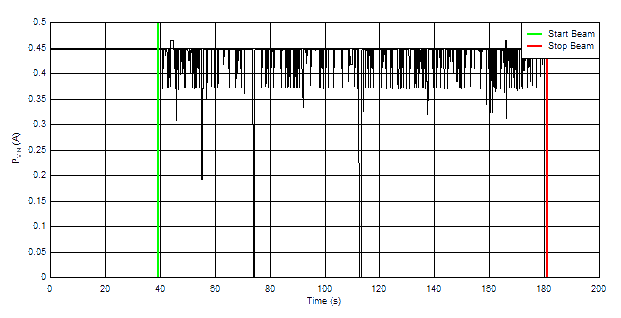SBOK044B December 2020 – December 2024 TPS7H4010-SEP
- 1
- 1 Abstract
- Trademarks
- 2 Introduction
- 3 Single-Event Effects (SEE)
- 4 Device and Test Board Information
- 5 Irradiation Facility and Setup
- 6 Depth, Range, and LETEFF Calculation
- 7 Test Setup and Procedures
- 8 Destructive Single-Event Effects (DSEE)
- 9 Single-Event Transients (SET)
- 10Event Rate Calculations
- 11Summary
- 12Revision History
- A Total Ionizing Dose from SEE Experiments
- B References
8.1 Single-Event Latch-up (SEL) Results
During SEL characterization, the device was heated using forced hot air, maintaining the DUT temperature at 125°C. The die temperature was monitored during testing using a T-Type thermocouple attached to the thermal pad vias (on the bottom side of the EVM) with thermal paste. The thermocouple was held in-place by using high temperature tape (kapton-tape). Die-to-thermocouple temperature was verified using a IR-camera.
The species used for the SEL testing was a Krypton (84Kr) ion with an angle-of-incidence of 44.38°, degraded by 3-steps of a degrader angle of 47.75° for an LETEFF = 43 MeV·cm2/mg (for more details refer to Section 6). The kinetic energy in the vacuum for this ion is 2.081 GeV (25-MeV/amu line). Flux of approximately 105 ions/cm2·s and a fluence of approximately 107 ions/cm2 were used for the four runs. Run duration to achieve this fluence was approximately 2 minutes. The two devices were powered up and exposed to the heavy-ions using the maximum recommended voltage of 32 V and maximum load of 6 A. No SEL events were observed during all four runs, indicating that the TPS7H4010-SEP is SEL-free. Table 9-3 shows the SEL test conditions and results. Figure 8-1 shows a plot of the current vs time for run # 1.
| RUN # | UNIT # | ION | LETEFF (MeV·cm2/mg) | FLUX (ions·cm2·s) | FLUENCE (# ions) | VOUT (V) |
|---|---|---|---|---|---|---|
| 1 | 1 | 84Kr | 43 | 9.79 x 104 | 9.99 x 106 | 1.8 |
| 2 | 2 | 84Kr | 43 | 7.06 x 104 | 1 x 107 | 3.3 |
| 3 | 3 | 84Kr | 43 | 8.56 x 104 | 9.98 x 106 | 1.8 |
| 4 | 4 | 84Kr | 43 | 1.1 x 105 | 9.97 x 106 | 3.3 |
σSEL ≤ 9.23 × 10–8 cm2/device for LETEFF = 43 MeV·cm2/mg and T = 125°C.
 Figure 8-1 Current vs Time for Run # 1 of the TPS7H4010-SEP at T = 125°C. NOTE: The current spikes are due to the output transients on the output voltage.
Figure 8-1 Current vs Time for Run # 1 of the TPS7H4010-SEP at T = 125°C. NOTE: The current spikes are due to the output transients on the output voltage.